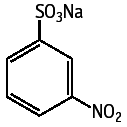

Sodium 3-nitrobenzenesulfonate was studied for oral toxicity in rats in a 28-day repeat dose toxicity test at doses of 0, 100, 300 and 1000 mg/kg. No animals of either sex in any group died. Salivation, considered to be caused by irritation with the test substance, was observed immediately after administration of sodium 3-nitrobenzenesulfonate in both sexes of the 1000 mg/kg dosage group and transiently continued. The test substance did not cause any changes in clinical signs, body weights, food consumption, urinary findings, results of hematological and blood chemical analysis and organ weights. Therefore, the NOEL for the 28-day repeat dose oral toxicity test of sodium 3-nitrobenzenesulfonate is considered to be 300 mg/kg/day for male and female rats.
Sodium 3-nitrobenzenesulfonate was not mutagenic in Salmonella typhimurium TA100, TA1535, TA98, TA1537 and Escherichia coli WP2uvrA.
Sodium 3-nitrobenzenesulfonate did not induce structural chromosomal aberrations or polyploidy in CHL cells with or without an exogenous metabolic activation system.
| Purity | : | 98.8 % |
| Test species/strain | : | Rats/Crj:CD(SD) |
| Test method | : | Guidelines for 28-Day Repeat Dose Toxicity Testing of Chemicals(Japan) |
| Route | : | Oral(gavage) |
| Doses | : | 0(vehicle), 100, 300, 1000 mg/kg/day |
| Number of animals/group | : | Males, 10; females, 10(0, 1000 mg/kg) Males, 5; females, 5(100, 300 mg/kg) |
| Vehicle | : | Water |
| Administration period | : | Males and females, 28 days |
| Terminal kill | : | Males and females, days 29 or 43 |
| GLP | : | Yes |
Test results:
| Purity | : | 98.8 % |
| Test species/strain | : | Salmonella typhimurium TA100, TA1535, TA98, TA1537, Escherichia coli WP2 uvrA |
| Test method | : | Guidelines for Screening Mutagenicity Testing of Chemicals(Japan) |
| Procedures | : | Pre-incubation method |
| Solvent | : | Distilled water |
| Positive controls | : | -S9 mix; 2-(2-Furyl)-3-(5-nitro-2-furyl)acrylamide(TA100, TA98, WP2uvrA), Sodium azide(TA1535) and 9-Aminoacridine(TA1537) +S9 mix; 2-Aminoanthracene(all strains) |
| Doses | : | -S9 mix; 0, 156, 313, 625, 1250, 2500, 5000 μg/plate +S9 mix; 0, 156, 313, 625, 1250, 2500, 5000 μg/plate |
| S9 | : | Rat liver, induced with phenobarbital and 5,6-benzoflavone |
| Plates/test | : | 3 |
| Number of replicates | : | 2 |
| GLP | : | Yes |
Test results:
Genotoxic effects:
S. typhimurium TA100, TA1535, TA98, TA1537
| + | ? | - | |
| Without metabolic activation: | [ ] | [ ] | [*] |
| With metabolic activation: | [ ] | [ ] | [*] |
E. coli WP2 uvrA
| + | ? | - | |
| Without metabolic activation: | [ ] | [ ] | [*] |
| With metabolic activation: | [ ] | [ ] | [*] |
| Purity | : | 98.8 % |
| Type of cell used | : | Chinese hamster lung(CHL)cells |
| Test method | : | Guidelines for Screening Mutagenicity Testing of Chemicals(Japan) |
| Solvent | : | JP saline |
| Positive controls | : | -S9 mix, N-methyl-N'-nitro-N-nitrosoguanidine +S9 mix, Benzo[a]pyrene |
| Doses | : | -S9 mix(24 and 48-hr continuous treatment): 0, 625, 1250, 2500, 5000 μg/mL -S9 mix(6-hr short-term treatment): 0, 625, 1250, 2500, 5000, μg/mL +S9 mix(6-hr short-term treatment): 0, 625, 1250, 2500, 5000, μg/mL |
| S9 | : | Rat liver, induced with phenobarbital and 5,6-benzoflavone |
| Plates/test | : | 2 |
| GLP | : | Yes |
Test results:
Genotoxic effects:
| clastogenicity | polyploidy | |||||
| + | ? | - | + | ? | - | |
| Without metabolic activation: | [ ] | [ ] | [*] | [ ] | [ ] | [*] |
| With metabolic activation: | [ ] | [ ] | [*] | [ ] | [ ] | [*] |
| 1) | The tests were performed by the Hatano Research Institute, Food and Drug Safety Center, 729-5 Ochiai, Hadano-shi, Kanagawa, 257-0025, Japan. Tel +81-463-82-4751 Fax +81-463-82-9627 |
| 2) | The tests were performed by the Research Institute for Animal Science in Biochemistry and Toxicology, 3-7-11 Hashimotodai, Sagamihara-shi, Kanagawa 229-1132, Japan. Tel +81-42-762-2775 Fax +81-42-762-7979 |